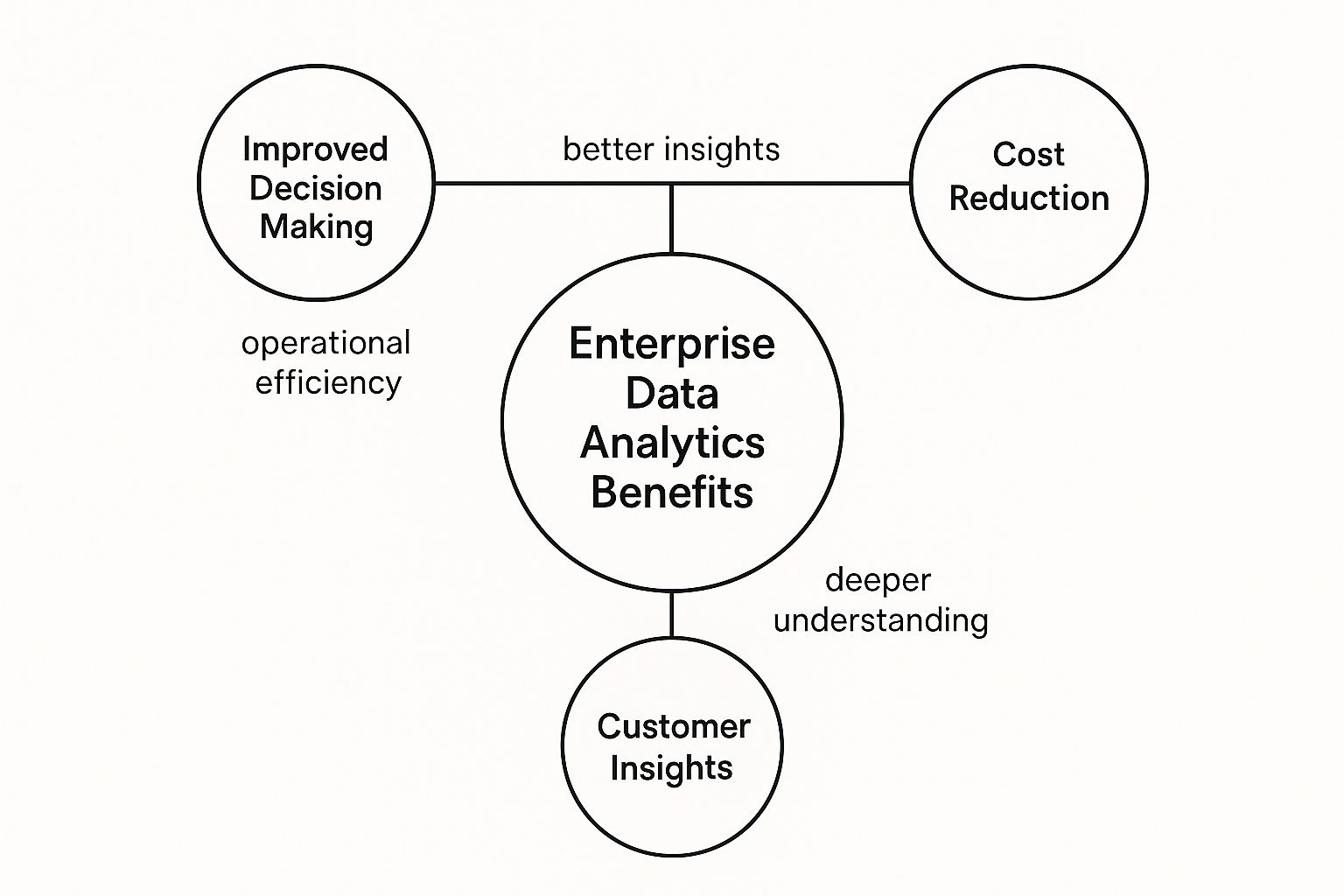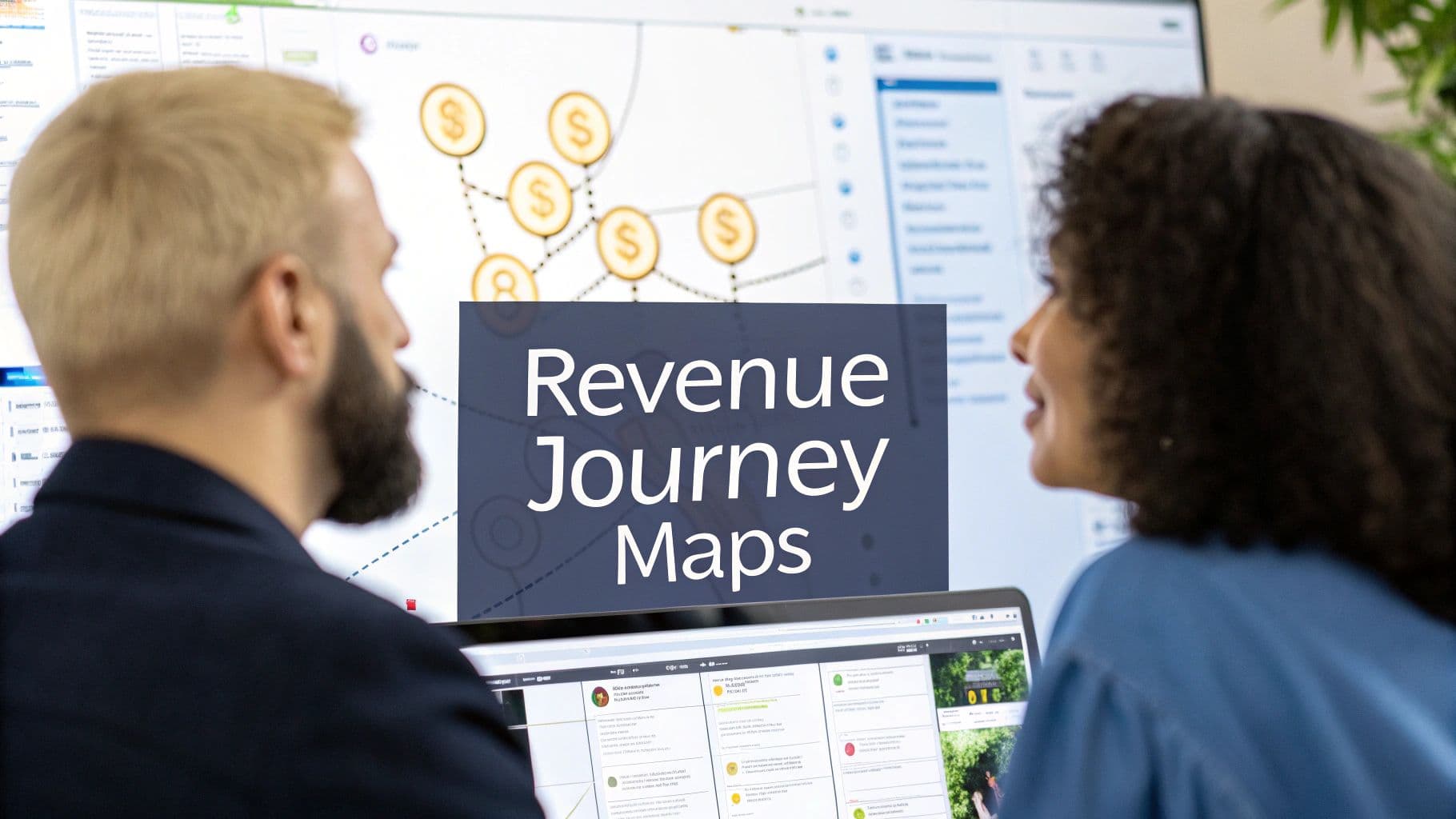Enterprise Data Analytics: Unlock Business Insights
Learn how enterprise data analytics drives smarter decisions. Discover tools and strategies to optimize your business with data-driven insights.

When you hear the term enterprise data analytics, it's easy to get lost in buzzwords. Let's cut through the noise. Think of it as the process of pulling together all the vast, messy data from every corner of your business to find the hidden patterns that actually matter.
This isn't just about making bigger reports. It's about getting a bird's-eye view of your entire operation to spot trends, forecast what's next, and make smarter, more strategic moves.
What Is Enterprise Data Analytics Really
Imagine your business isn't just a collection of departments, but a single, living organism. Enterprise data analytics is the central nervous system for that organism. It gathers signals from everywhere—sales, marketing, HR, logistics, finance—and turns them into coordinated, intelligent actions that drive the whole company forward.
This is the key difference between EDA and smaller, departmental analytics. A marketing team might track clicks on a specific ad campaign, and the finance team is definitely watching quarterly expenses. Those are valuable insights, but they're isolated.
Enterprise data analytics connects those dots. It answers the bigger questions, like how that marketing campaign's success directly led to a surge in high-value customer sign-ups and, surprisingly, a 15% drop in support tickets from that same group. That's a story you can't see from a single dashboard.
Beyond Departmental Dashboards
The real magic of enterprise data analytics is its scale and strategic vision. We’re not just building another siloed dashboard for the sales team. The goal is to create a single, reliable source of truth that gets everyone, from the C-suite to the front lines, rowing in the same direction.
This unified approach turns scattered, raw data into a powerful, cohesive asset. Why is this so important?
- Holistic Decision-Making: Leaders can finally see the whole board, understanding how a decision in one department will create ripples across all the others.
- A Sharper Competitive Edge: You can spot subtle market shifts and anticipate customer needs far faster than competitors who are still stuck looking at their own little piece of the puzzle.
- Fuel for Smart Growth: By pinpointing which customers are most profitable or which processes are secretly draining resources, the business knows exactly where to invest for the biggest return.
The Foundation for Modern Business
Ultimately, this is all about turning data into a real competitive advantage. It’s the difference between being reactive (fixing problems after they’ve already cost you money) and proactive (predicting issues and opportunities before they even arrive).
In today's complex world, getting this right isn't just a "nice-to-have." It’s the bedrock of sustainable growth and the reason why a powerful, integrated analytics platform is no longer optional.
Building Your Modern Data Analytics Engine
To really get a handle on enterprise data analytics, it helps to look past the code and think of it as something more familiar. Imagine a sophisticated city water system, engineered to deliver a vital resource—in this case, clean, usable data—to every part of your organization.
This system starts at its sources, which are like vast, sprawling reservoirs. Each reservoir is a different wellspring of raw data: your CRM, ERP software, customer support platforms like Zendesk or Intercom, website analytics, and even unstructured information from sales call transcripts. Like reservoir water, this raw data holds immense potential, but it isn’t quite ready to drink.
The Journey from Raw Data to Actionable Insight
First, you need a way to move all that raw data. This is where a network of aqueducts comes in—the data ingestion pipelines that transport information from its source to a central location. This process, often called ETL (Extract, Transform, Load) or ELT (Extract, Load, Transform), is the critical first step in making sense of everything.
These pipelines pull data from dozens of disconnected systems and channel it all toward a central processing plant. In the data world, this plant is a data warehouse or a data lakehouse. This is where raw information from every corner of the business is collected, stored, and prepared for analysis. Modern platforms typically use scalable cloud storage for this, which lets them handle enormous volumes of information without breaking a sweat.
Refining and Purifying Information
Once the raw data is centralized, the real work begins. This is where analytics engines and processing frameworks act like advanced purification stations. They sift through all the collected data, cleaning it up to remove inconsistencies, standardizing formats, and structuring it for analysis. This step is absolutely crucial; without it, you're just making decisions based on flawed or incomplete information.
This is also where the intelligence layer comes into play. For example, a platform like SigOS connects directly to sources like support tickets and call transcripts. But it doesn't just move this data. Its AI-driven engine actually analyzes the unstructured text to find patterns, quantify the revenue impact of bugs, and score the potential value of feature requests. It's actively purifying the data by turning qualitative noise into quantitative, actionable signals.
The infographic below highlights the core benefits that pop up when this entire system works in harmony.

As you can see, a well-built analytics engine creates a direct line from refined data to smarter decisions, better efficiency, and a much deeper understanding of your customers.
Delivering Insights Directly to Your Team
Finally, what good is purified water if you can't get it from the tap? The last mile of this journey involves data visualization and business intelligence (BI) tools. These are the faucets of our system, delivering crystal-clear insights directly to the people who need them in a format they can actually use.
These tools transform complex datasets into intuitive dashboards, charts, and reports. This allows different departments—from product management to sales—to simply turn the handle and get the specific insights they need, right when they need them. A product manager might see a dashboard showing which feature requests are tied to the biggest expansion opportunities, while a support leader gets a real-time chart of issues correlated with customer churn risk.
A modern enterprise data analytics platform acts as the unified control center for this whole system. It manages the flow from reservoir to faucet, making sure the entire process is seamless, secure, and reliable. By automating this complex technical stack, it turns a tangled web of data into a streamlined asset that empowers every team to act with confidence and clarity.
The Tangible Benefits of a Unified Data Strategy

A well-designed enterprise data analytics architecture isn't just a technical trophy to put on the shelf; it's a powerful engine for real business growth. When you get data flowing seamlessly from every corner of the organization, you start to unlock outcomes that directly hit the bottom line. So, let's move past hypotheticals and look at how a unified strategy actually translates into clear, measurable ROI.
It's these kinds of benefits that are fueling massive investment in the tools that make it all happen. The global market for enterprise data management was pegged at around USD 97.5 billion in 2023. Projections show it soaring to USD 281.9 billion by 2033, which tells you everything you need to know about its importance. You can dig deeper into these numbers in this enterprise data management report.
Slashing Operational Waste with Predictive Forecasting
Let's start with a classic e-commerce challenge: inventory management. Imagine a major retailer drowning in data but struggling to make sense of it. By bringing together sales history, supply chain logistics, and even external market trends into one view, they can finally move beyond just looking in the rearview mirror.
With predictive analytics, they can now forecast demand with surprising accuracy. They know which products are going to fly off the shelves during the holidays and which will just gather dust. The result? A massive reduction in overstocking and the painful warehouse fees that come with it. In one real-world case, a retailer used this very approach to slash inventory waste by 30%, turning a huge cost center into a source of savings.
Optimizing Complex Logistics in Real Time
Now, picture a national logistics company with thousands of trucks on the road every single day. Fuel is a monster expense, where even tiny inefficiencies snowball into millions of dollars lost. This is where a unified data strategy becomes non-negotiable.
By integrating real-time GPS data, live traffic patterns, weather forecasts, and vehicle maintenance schedules, the company can optimize delivery routes on the fly. A central system can instantly tell a driver to avoid a sudden traffic jam or tweak the day's schedule to burn less fuel. You simply can't achieve that level of agility when your information is locked away in different systems.
This is a perfect example of how enterprise data analytics connects seemingly unrelated data points to create immediate financial wins.
Deepening Customer Understanding and Reducing Churn
Perhaps the biggest win of all is getting a true 360-degree view of your customer. When support tickets, sales call notes, product usage logs, and billing history all live in the same place, you start seeing patterns that were completely invisible before.
For a SaaS company, this is gold. An AI-powered platform like SigOS can comb through this unified data to, for example, connect specific product bugs mentioned in support tickets to a dip in usage from a high-value account. It can spot which feature requests from prospects are consistently tied to deals that actually close.
This insight leads to several powerful outcomes:
- Proactive Churn Prevention: Teams get a heads-up when a customer's behavior suggests they might be about to leave, giving them a chance to step in before it's too late.
- Revenue-Driven Roadmaps: Product managers can stop guessing and start prioritizing features that are statistically proven to drive upsells or win major new business.
- Enhanced Customer Experience: By pinpointing the exact friction points in the customer journey, teams can make targeted fixes that boost satisfaction and build real loyalty.
Ultimately, a unified data strategy shifts decision-making from an art based on gut feelings to a science based on hard evidence. It creates a culture where every team is aligned, empowered by clear insights, and laser-focused on delivering measurable value.
Navigating Common Data Analytics Challenges

Starting an enterprise data analytics program is a game-changer, but let's be realistic—it's not a walk in the park. Like any major initiative that promises to reshape your business, the path is loaded with potential pitfalls that can stop you in your tracks. Knowing what these hurdles are ahead of time is the best way to build a data-driven culture that actually lasts.
The toughest challenges aren't just about technology. They're human. They’re baked into how your company operates, from departmental politics to legacy processes. Each one needs a thoughtful, strategic approach to solve.
Breaking Down Data Silos
One of the first and most common walls you'll hit is data silos. This is what happens when different departments—marketing, sales, finance—all have their own data, locked away in separate systems. They guard it, they control it, and as a result, no one gets the full picture. You can't see the entire customer journey or understand how one team's actions affect another.
The fix isn't just about buying a new tool; it's about fostering a culture of sharing. A great first step is to create a data governance council with leaders from every key department. Their job is to agree on a single set of rules and definitions so everyone starts speaking the same data language.
Ensuring High-Quality Data
Here's a hard truth: garbage in, garbage out. If the data you're feeding into your analytics platform is messy, incomplete, or just plain wrong, your insights will be useless. Even worse, they could be dangerously misleading, pointing you toward costly mistakes.
You have to build a solid data quality framework right from the start. This means:
- Automated Cleansing Tools: Put software in place that can spot and fix errors, find duplicates, and clean up inconsistencies on the fly.
- Data Validation Rules: Set up strict rules where data is first entered to stop bad information from getting into your systems.
- Ownership and Accountability: Make it crystal clear who is responsible for the quality of specific data sets. When someone owns it, it stays clean.
The Growing Tech Talent Gap
Finding people who can blend data science, engineering, and real-world business sense is tough. The demand for skilled data professionals far outweighs the supply, which makes for a fiercely competitive—and expensive—hiring landscape.
While you'll always need to hire key people, a smarter long-term play is to upskill the talent you already have. By investing in training and creating data literacy programs, you empower your current employees to become more confident and capable with data. This not only fills the skills gap but also strengthens your data culture from the ground up.
Adding to the complexity is the web of regulatory compliance. The U.S. enterprise data market alone is expected to hit USD 37.4 billion by 2033, and much of that growth is shaped by privacy laws like the CCPA. This means you need people who don't just understand data but also the legal frameworks that govern it. You can explore more on the U.S. enterprise data market evolution to see how these trends are unfolding.
Successfully navigating these hurdles requires a mix of technology, clear strategy, and a real commitment to changing how your organization thinks about data. Let's break down how to tackle these common issues head-on.
Overcoming Common Enterprise Data Analytics Hurdles
A summary of the most frequent challenges in implementing enterprise data analytics and the strategic solutions to address them effectively.
| Challenge | Primary Impact | Effective Solution |
|---|---|---|
| Data Silos | Fragmented business view, inconsistent reporting, and missed cross-functional insights. | Establish a cross-departmental data governance council and create a unified data architecture. |
| Poor Data Quality | Unreliable analytics, flawed decision-making, and a loss of trust in data-driven initiatives. | Implement automated data cleansing, validation rules at the point of entry, and assign clear data ownership. |
| Talent Shortage | Difficulty hiring skilled professionals, project delays, and an inability to scale analytics efforts. | Invest in upskilling the existing workforce, foster internal data literacy, and partner with specialized vendors. |
| Regulatory Compliance | Risk of fines, data breaches, and reputational damage from mishandling sensitive information. | Integrate compliance into the data governance framework and employ tools with built-in security features. |
By proactively addressing these issues, you can clear the path for your enterprise data analytics program to deliver on its full potential and drive meaningful business results.
A Blueprint for a Winning Analytics Strategy

Having the best technology doesn't guarantee success. The real difference between a high-impact analytics program and an expensive failure comes down to the game plan. A solid strategy is the roadmap that connects your tech stack to tangible business goals, turning data from a simple cost center into a powerful competitive edge.
The most common trap I see companies fall into is starting with the data itself—hoarding every byte they can get and just hoping for a "eureka" moment. The best strategies flip this on its head. They always start by asking, “What critical business problems are we trying to solve?” This focus ensures every bit of effort is tied directly to a meaningful outcome, whether that's cutting customer churn or making your supply chain more efficient.
Start with Business Questions, Not Data
Before you even think about analyzing a single row of data, nail down your objectives. Are you trying to figure out why your best customers are walking away? Do you need a more accurate inventory forecast for the next quarter? Frame your goals as specific, answerable questions.
This approach acts as a powerful filter. It tells you precisely which data you need, what kind of models to build, and how you’ll know if you’ve succeeded. Without that clarity, analytics projects tend to wander aimlessly, burning through resources without ever delivering real value.
A question-first mindset also helps you avoid "analysis paralysis," that all-too-common state where teams get so buried in data they don't know where to even begin. Instead, it channels their energy toward solving real problems from day one.
Build a Foundation of Data Governance
Once your goals are set, the next critical piece is data governance. Think of it as the official rulebook for your data. It defines who can access what, what each piece of data actually means, and how you're going to keep it clean and reliable. Good governance is what builds trust in the numbers across the entire company.
Without it, you get chaos. Different departments use different definitions, metrics don't line up, and before you know it, nobody believes the reports they’re seeing. Key parts of solid governance include:
- Data Stewardship: Assigning clear owners for different data sets. These are the people responsible for making sure the data is accurate and well-maintained.
- Access Controls: Setting up role-based permissions so people only see the data they need to do their jobs, keeping sensitive information secure.
- Standardized Definitions: Creating a single source of truth—a business glossary—so that when someone says "active customer," it means the exact same thing to everyone in marketing, sales, and finance.
Foster Widespread Data Literacy
Your strategy is only as good as the people who have to use it. This means you have to invest in data literacy—the ability for everyone, in every department, to read, understand, and talk about data. The goal isn't to turn every employee into a data scientist.
It’s about giving them the confidence to ask better questions and use insights to make smarter decisions in their day-to-day work. You can get there with focused training, easy-to-use self-service analytics tools, and by building a culture where being curious about data is celebrated. Getting an executive sponsor on board is key here; their support gives the initiative the visibility and resources it needs to truly take hold and create a company-wide shift.
How Top Industries Use Enterprise Data Analytics
The real magic of enterprise data analytics isn't in the technology itself, but in how it solves tangible, high-stakes problems. When you see it in action, everything clicks. From protecting financial systems to making healthcare more personal, a solid data strategy is what's driving some of the most important advancements today.
This practical impact is fueling explosive growth for the tools that make it all happen. The market for advanced analytics—a key piece of this puzzle—was valued at USD 75.89 billion in 2024. That number is expected to jump to an incredible USD 305.42 billion by 2030. This isn't just hype; it reflects a fundamental shift as businesses increasingly rely on AI and predictive models to make sense of their data. You can dig deeper into the advanced analytics market growth on Grand View Research.
Fortifying Finance and Managing Risk
In the financial world, every millisecond and every decimal point counts. Banks and investment firms use enterprise data analytics to watch millions of transactions as they happen, running them through sophisticated fraud detection models. These systems get to know a customer's typical spending habits so they can instantly spot something strange—like a credit card being used in two different countries minutes apart—and stop theft in its tracks.
It's not just about security, though. These same platforms are crucial for managing the enormous risk tied to investment portfolios. By pulling in market trends, historical data, and economic forecasts all at once, firms can run simulations to see what might happen and make smarter moves to protect their clients' money.
Revolutionizing Healthcare and Patient Outcomes
When it comes to healthcare, data can literally be a matter of life and death. Hospitals and clinics are using enterprise data analytics to connect the dots between electronic health records, lab results, and even genetic information. Having this complete picture helps them spot at-risk groups and predict potential disease outbreaks before they become a crisis.
By analyzing treatment effectiveness across thousands of similar patient profiles, doctors can move toward highly personalized medicine. This data-driven approach ensures patients receive the most effective therapies for their specific condition, improving outcomes and reducing wasted healthcare spending.
This shift turns reactive treatment into proactive health management, which ultimately builds a smarter and more effective system for all of us.
Optimizing Manufacturing with Predictive Maintenance
On a factory floor, unplanned downtime is the enemy. When a critical machine breaks, it can bring the entire production line to a halt, costing a fortune. To get ahead of this, manufacturers are outfitting their equipment with Internet of Things (IoT) sensors. These tiny devices stream a constant flow of data on things like temperature, vibration, and performance back to a central analytics hub.
This is the heart of predictive maintenance. Instead of just waiting for something to fail, the system sifts through the data looking for faint signals of wear and tear. It can then predict that a specific part is likely to fail in the next week, giving the maintenance team a heads-up to schedule a repair during planned downtime.
This smart approach delivers some big wins:
- Reduced Downtime: It catches problems before they cause surprise shutdowns.
- Lower Maintenance Costs: Proactive repairs are far cheaper than emergency fixes.
- Extended Equipment Lifespan: Taking better care of machinery helps it last longer.
From the stock market to the assembly line, these examples make it clear that enterprise data analytics isn't just an abstract idea—it's a powerful tool. It gives organizations the clarity they need to tackle their toughest challenges and jump on their biggest opportunities.
Answering Your Top Questions About Enterprise Data Analytics
When companies start exploring a serious data analytics strategy, the same practical questions always come up. Leaders want to know what the payoff is, how to get started without a massive headache, and how this is any different from the BI tools they already have. Let's dig into those common questions.
How Do We Measure the ROI?
This is usually the first question, and for good reason. "What's the return on this investment?" The best way to answer it is to look at both the hard numbers and the softer, but equally important, strategic gains.
The direct ROI is often the easiest to track. We're talking about tangible results you can put on a spreadsheet.
- Saving Money: You might find operational waste you never knew existed. A classic example is a logistics company using route analysis to slash its fuel budget by 12%. That’s a direct hit to the bottom line.
- Making More Money: Analytics can uncover your most profitable customer segments or pinpoint the perfect moment to offer an upsell, leading to direct, measurable revenue growth.
But don't overlook the indirect benefits. These are the game-changers that are harder to quantify but can have a massive impact, like making smarter decisions faster and getting everyone on the same page, all working from the same set of facts.
Where Should We Start?
The next big question is usually, "Where do we even begin?" The temptation is to go big—to launch a massive, company-wide project. That’s almost always a mistake. The real key to success is to start small and focused.
First, get a clear-eyed look at where you are today with a data maturity assessment. This will show you what’s working and where the real gaps are. Armed with that knowledge, pick one specific, nagging business problem and launch a pilot project to solve it. This gives you a quick win, proves the value of the approach, and builds the momentum you need to expand.
A successful enterprise data analytics journey doesn't start with boiling the ocean. It begins by choosing a single, valuable pond, proving you can make a difference there, and then expanding your efforts with the credibility you've earned.
How Is This Different From Traditional BI?
Finally, people often ask how this compares to the business intelligence (BI) they've used for years. It's a fair question—they're related, but they play very different roles.
Think of traditional BI as your rearview mirror. It’s fantastic at descriptive analytics, showing you what happened in the past through reports and dashboards. It's all about historical performance.
Enterprise data analytics, on the other hand, is like your GPS and forward-looking radar combined. It goes deeper to explain why something happened and then uses predictive models to tell you what's likely to happen next. It’s the shift from simply reporting on the past to actively shaping your future.
Ready to turn your customer feedback into a predictable revenue engine? SigOS uses AI to analyze support tickets, sales calls, and usage data, automatically identifying the issues costing you money and the features that will drive major growth. Prioritize your roadmap with confidence.
Keep Reading
More insights from our blog


